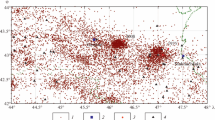Abstract
Earthquakes that occur on the territory of Vietnam and especially in the South China Sea are a major hazard to the Vietnam population and infrastructure because of possible destruction and tsunamis, like those took place there in earlier times according to geological data. Therefore, in the early 2000s, the government of Vietnam decided to modernize and expand the network of seismological observations on the territory of the republic. First, it was planned to modernize the seismic network in Vietnam with 20 broadband seismic stations and then increase that number to 30. This raised the problem of the optimal arrangement of these stations in the country to predict earthquakes and study the structure of the crust and upper mantle of Vietnam. The map of Vietnam clearly shows the impossibility of constructing a single optimal observation network to locate earthquake hypocenters over the entire territory, because it is strongly elongated from north to south. Any seismological observation network for such an entire territory will not be optimal. In this case, we can speak about improving local observation networks for some areas, such as the north, center, and south of the country. This work estimates the efficiency (distribution of the minimum representative magnitudes and the error in determining the coordinates of earthquake hypocenters) for the new network of seismological observations in Vietnam, consisting of 30 stations. To improve the quality of the network in central and southern Vietnam, six more seismic stations are proposed. Such a network will allow more accurate determination of the hypocenter parameters in central and southern Vietnam. During the construction of the optimal network configuration, one of the main problems was the choice of an effective network radius. The formula for determining the optimal radius in the seismic observation network is obtained for the case of a uniform distribution of hypocenters in a certain cylindrical region based on the radius of the base and height of this cylinder. In this work, it follows from the formula that the radius of the optimal network should be no less than the radius of the hypocentral region. In our case, the choice of network radius is confined within the state borders and coastline of Vietnam. These restrictions are taken into account in the calculations to optimize the number of seismic stations and the configuration of their location in the country.
Similar content being viewed by others
References
Burmin, V.Yu., Optimal arrangement of seismic stations when recording close earthquakes, Fiz. Zemli, 1986, no. 5, pp. 34–42.
Burmin, V.Yu., Optimizatsiya seismicheskikh setei i opredelenie koordinat zemletryasenii (Optimization of Seismic Networks and Determination of Earthquake Coordinates), Moscow: Ob”ed. Inst. Fiz. Zemli Ross. Akad. Nauk, 1995.
Burmin, V.Yu. and Akhmet’ev, V.M., Errors in determining hypocentral parameters of close earthquakes and efficiency of the seismological observation system, Vulkanol. Seismol., 1994, no. 2, pp. 109–128.
Burmin, V.Yu. and Nguen Van Fong, Planning the optimal regional seismic network for Southeast Asia, Vulkanol. Seismol., 2001, no. 1, pp. 68–75.
Burmin, V.Yu., Ngo Thi Lu, and Tran Viet Phyong, Estimation of efficiency of the modern and planning optimal network of seismic stations within the Vietnam territory, Seism. Instrum., 2010, vol. 46, no. 1, pp. 27–37.
Ngo Tkhi Ly and Nguen Kuang, Seismicity of Northern Vietnam and adjacent regions (earthquakes of 1987–1992), Izv., Phys. Solid Earth, 1997, vol. 33, no. 4, pp. 314–318.
Author information
Authors and Affiliations
Corresponding author
Additional information
Original Russian Text © V.Yu. Burmin, Ngo Thi Lu, Phung Thi Thu Hang, Le Quang Khoi, 2017, published in Seismicheskie Pribory, 2017, Vol. 53, No. 3, pp. 74–86.
About this article
Cite this article
Burmin, V.Y., Lu, N.T., Hang, P.T.T. et al. Estimating the Efficiency of the New Seismic Network in Vietnam. Seism. Instr. 54, 281–292 (2018). https://doi.org/10.3103/S0747923918030040
Published:
Issue Date:
DOI: https://doi.org/10.3103/S0747923918030040




